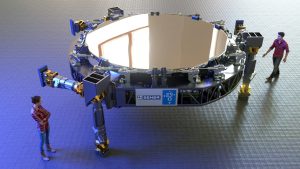Article written by Pradeep Nayak
For any astronomical telescopic observation, ‘the larger is the better’. After the invention of telescope, astronomers have been trying to build larger and larger telescopes. Earlier telescopes were refracting type that is, made of lenses. When astronomers started developing large lenses, they realized that there is a limit for it.
A large optical lens is extremely difficult to hold. Its weight becomes very high and its shape gets distorted because of sagging. The largest refracting telescope in the world is 40 inch in diameter, slightly larger than just 1 metre. It is situated at Yerkes Observatory near Wisconsin in USA.
It is relatively easy to make a mirror than a lens. Hence reflecting telescopes are more popular in the world of astronomy. Professional astronomers demand for larger and larger telescopes all the time. Hale Telescope on Mount Palomar in USA is one of the most famous telescopes in the world. Started in 1949, it ruled the world for more than thirty years as the largest optical telescope. Its diameter is 5 metres. Then came 6-metre telescope built by Russia in 1978 and dethroned Hale telescope.
In 1993, a 10-metre behemoth, Keck-I Telescope saw the first light which became the largest telescope in the world surpassing the size of Russian telescope by 4 metres. This telescope is situated near the summit of Mauna Kea in Hawaii. Within three years second 10-metre telescope, Keck-II Telescope, completed construction. Both Keck-I and Keck-II telescopes are revolutionary in design in the sense that their mirrors are not single piece glass mirrors. Instead, several smaller hexagonal mirrors are joined together to form large 10-metre aperture. This technology allowed us to overcome the technical limit of a single piece mirror. All the telescopes larger than Keck telescopes are now multi-segment mirrors including James Webb Space Telescope which is 6.5 metres in diameter.
USA started building a telescope much larger than Keck telescopes having 30-metre diameter. This telescope will see its first light in 2027. The multi-segment mirror technology enabled us to build really large telescopes without limit. A Thirty Metre Telescope (TMT) is just the beginning of the next telescope revolution. In a friendly competitive spirit, a European Union consortium European Southern Observatory is trying to surpass TMT milestone by building its own telescope larger that TMT. After an extremely ambitious thought of building 100-metre diameter telescope, they settled down to 39.3-metre telescope and named it as Extremely Large Telescope (ELT). Construction of ELT was started in 2012 at the site on Cerro Armazones, a 3,046-meter-tall mountain in the Atacama Desert in Chile. This place is chosen as it is one of the driest high-altitude places in the world.

Box: Initially European Southern Observatory was planning to build a hundred metre diameter telescope namely Overwhelmingly Large Telescope (OLT). When feasibility study was completed, it was realised that the cost will be too high, almost 2 billion US dollar, and such a telescope functioning will be extremely complex. So, the idea was scraped. Comparatively, ELT will cost 1.5 billion dollars whereas James Webb Space Telescope costed whopping 8 billion dollars.
When ELT sees its first light, most probably in 2027, it will be the largest telescope in the world. It may continue wearing the diadem of ‘the largest telescope’ at least for a few decades. The primary goal of ELT is to study extrasolar planets. With its huge size and large light gathering area, it will be able to take actual optical photograph of exoplanets. It will study atmosphere of such Earth-like exoplanets. ELT can probe objects at the farthest distances and study formation primordial galaxies and stars. It will also make a direct measurement of acceleration of expansion of universe.
As already mentioned, ELT is not a single one-piece mirror. Instead, it has 798 hexagonal segments. Each segment has a diameter 1.45 metres with a thickness of just 50 mm, weighing each segment assembly to almost 250 kg. More than 2400 position actuators fixed below the segments will maintain the accurate shape of the mirror. The mirror may get distorted due to external factors like temperature, vibrations, wind, etc. Actuators will keep the overall shape of mirror unchanged by adjusting to these factors. All the mirrors are made of very special lithium aluminosilicate glass-ceramic which has a very low coefficient of thermal expansion. Each segment requires regular maintenance to maintain reflectivity and sensitivity. For this each mirror needs to be recoated every 18 months. Due to this constraint 133 extra mirror segments will be kept ready. As the number of segments is very high, it turns out that two segments need to be replaced daily for recoating. This regular maintenance will ensure best possible image quality and long life of the mirror.

ELT system has five separate mirrors. Main objective mirror known as primary mirror or M1 has a diameter of 39.3 metres. Secondary mirror or M2 as it is known is a convex mirror having diameter 4.2 metres. It is the largest convex secondary mirror ever made. In most of the very large telescopes, tertiary mirror is a flat mirror to divert the reflected rays towards the detectors or instruments. In ELT, the tertiary mirror or M3 is a concave mirror, again with a large diameter of 4 metres. This is larger than India’s largest telescope (3.6 metres) at Nainital. The quaternary mirror also known as M4 is a very special 2.4-metre diameter flat mirror, well, almost flat. This mirror is special because it is just 2 mm thick and fitted with about 8000 actuators. It is an adaptive mirror which improve the resolving power of the telescope by a factor of 500 (!). The quinary i.e., the fifth mirror named as M5 is a tip-tilt adaptive mirror which is elliptical is size, 2.7 metres by 2.2 metres. This mirror will direct the celestial light towards a host of instruments.
Just as the expectations from James Webb Space Telescope are very high, prospects of ELT delivering big science goals are monumental. ELT will change our perspective about exo-planets and the earliest universe. The astronomers all over the world are eagerly waiting ELT to see its first light. Hopefully we will also get the answers to the most pressing issue of dark energy that cosmologists are facing. Will ELT deliver the promises? Will ELT the milestone in telescope building? Will 100-metre diameter telescope become a reality? Only time will tell.




